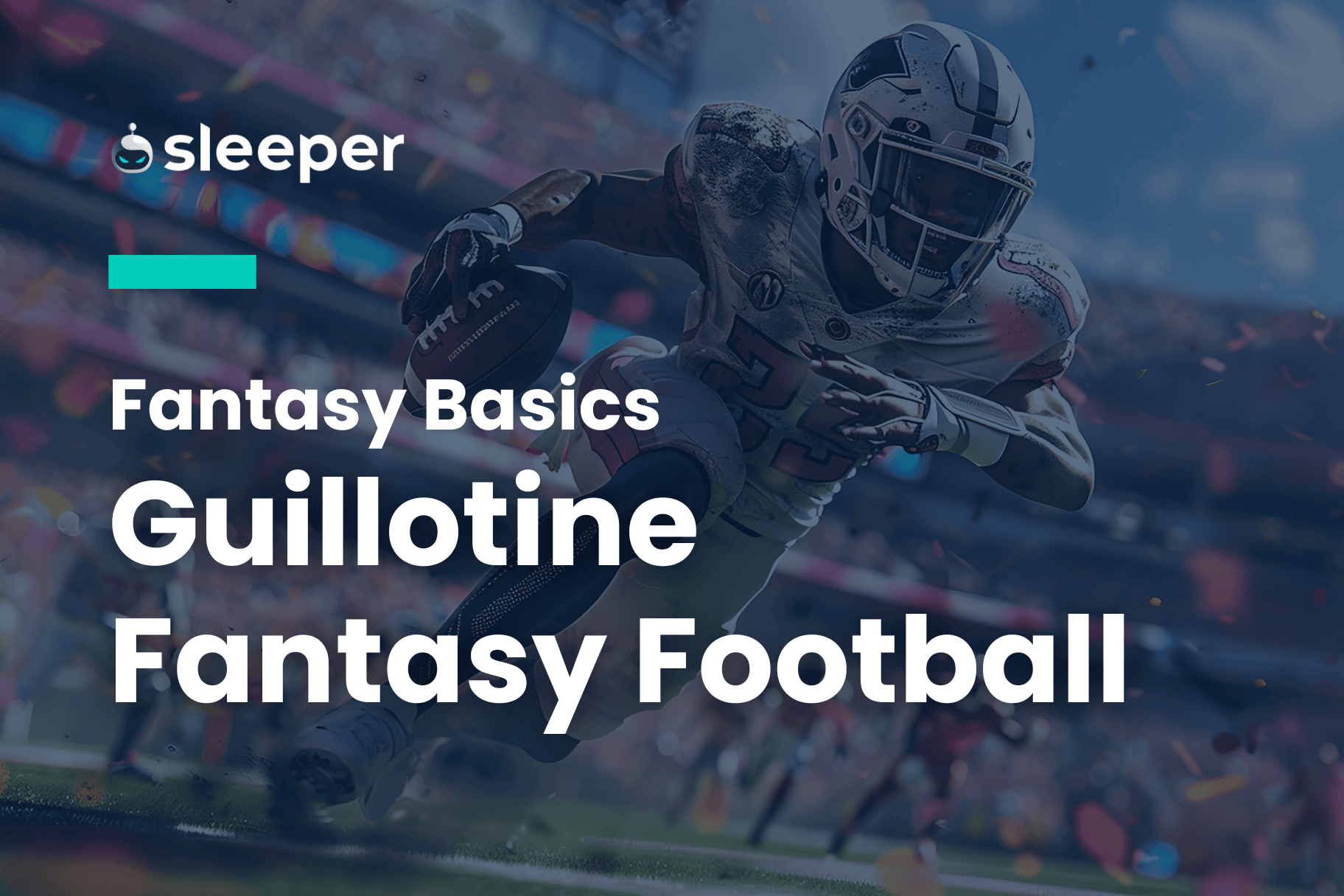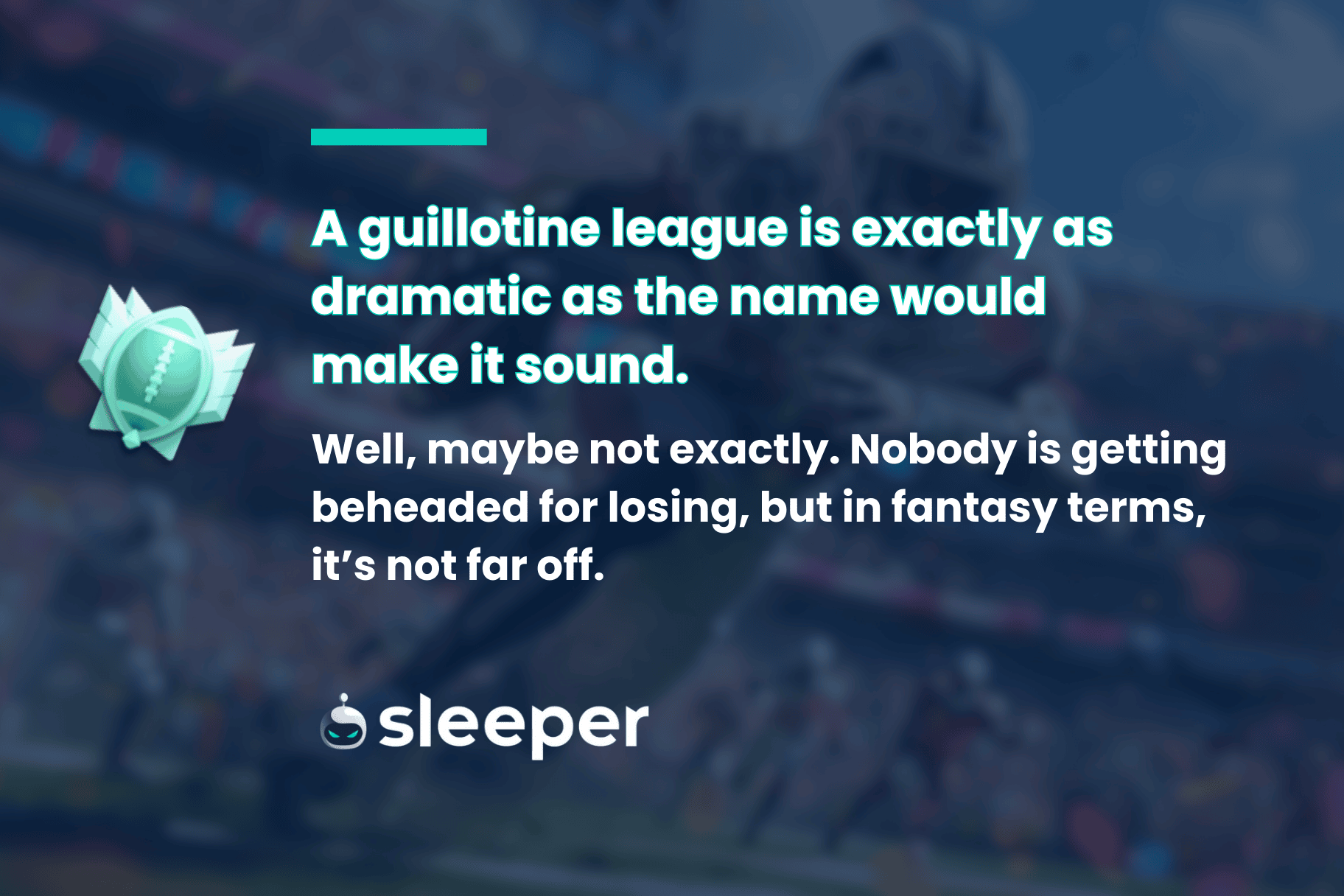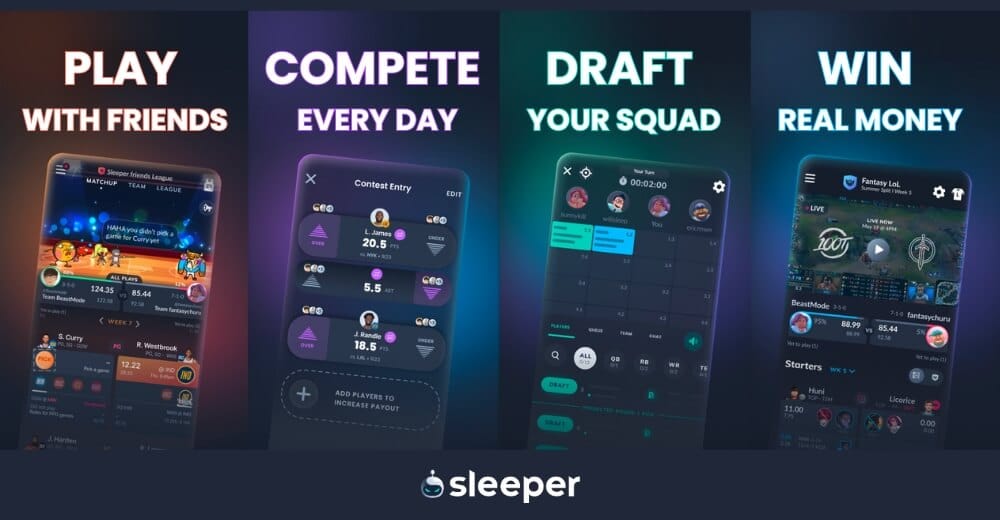For a new kind of fantasy football experience or just to expand your horizons, learn all about guillotine leagues and how to navigate this new terrain

Each fantasy football format has its own unique wrinkles, some more traditional than others. For instance, there are PPR leagues, which reward the pass-catchers for simply corralling the ball, as opposed to non-PPR leagues, where yards and touchdowns are what matters for skill-position players. That’s straightforward enough.
But for those seeking a radical change to their fantasy football experience along with some high-stakes sweats, let us introduce you to the beauty of a league as ruthless as its name: the guillotine league.
What is a Guillotine League?
A guillotine league is exactly as dramatic as the name would make it sound. Well, maybe not exactly. Nobody is getting beheaded for losing, but in fantasy terms, it’s not far off. Every week, managers set their rosters per usual, but — and here’s the catch — every week, the last-place finisher is eliminated from the league (it’s not a head-to-head venture; every team’s weekly fantasy points establish the ranking order). Season over. Straight to the chop. And even more, when the loser gets the boot, that team’s players are dispersed throughout the league via blind waiver bidding. How’s that for a twist?

It’s the kind of league that makes managers consider their approach to setting their squads. The high-risk choices might not be worth it on a weekly basis given the penchant for those players to bust. Playing it safe might not keep you atop the standings, but it does raise your floor, and if weekly survival is the goal, then an average team is going to be good enough (to a point).
Here some other features of a guillotine league:
Number of teams
For a guillotine league to function from the start of the NFL season until the end, it must have 18 teams, to account for the 18 weeks of the football calendar. While there can be fewer teams than 18, it would just ensure the league ends before the regular season does.
Lineup and rosters
This part functions as normal, save for the fact that in an 18-team league, you’re going to find yourself looking way down the draft cheat sheet earlier than you’d like. Each league should be customizable when it comes to lineup construction and roster size (14-16 players is normal), and some platforms may omit kickers and defense/special teams units in order to remove the sporadic nature of those positions from the elimination equation.
Waiver wire
Waivers operate under a free agent acquisition budget system (FAAB), where managers have a higher cap than in a more traditional league. That’s because the weekly dispersal of a loser’s roster should set off a spending frenzy (at least for the top-end talent), and the settings accommodate for the change in player acquisition methods.
No matter what, a few early-round players will be available for the highest bidders after Week 1, which is unfathomable in any other fantasy format.
Scoring system
The scoring is down to each commissioner and league’s preferences, but it doesn’t have to stray far, if at all, from traditional fantasy points. Make sure to check your league’s scoring settings before drafting, given that, in fantasy context, it really could be a matter of life and death.
Guillotine League Draft Strategy: 6 Tips to Win
So how do you navigate your league so you avoid the wrath of the blade? Follow these tips:
1. Draft players that show consistent results
It’s easy to puff out your chest after a draft that you think gives you a can’t-miss squad, but those big swings can also result in some colossal duds. You don’t necessarily want peaks and valleys across your lineup. You want a nice, healthy plateau, where you know the floor should be fortified.
2. Be ready to pounce with your FAAB
The waiver madness for dispersed players from eliminated teams is really unlike any other league you’ve ever experienced. Note where your team can use a big boost — especially if an otherwise-crippling bye is near or if one of your stars just suffered a colossal injury — and then be ready to unload your budget aggressively to ensure you land the player(s) you really need.
3. Look for players with late-season byes
In a more standard fantasy league, you can likely get away with punting on a week with byes stacked up and down your roster. If in, say, Week 6, you’re reduced to waiver-wire fodder at your skill positions because of a byepocalypse, you might swallow a likely L because you won’t really have to worry about byes for the rest of the season.
That mindset won’t fly with the guillotine looming. The later your studs are on bye, the better, as it’ll likely help you avoid that last-place doom and delay your toughest decisions until the prize is within reach.
As you accumulate talent through the waiver process to strengthen your overall squad, it could make your bye-week problems effectively moot if you’ve been able to hold off on encountering mass byes while stockpiling reinforcements.
4. Avoid players with risk factors
Playing it safe is really the name of the game here. Especially if you’re in an 18-team draft, you can’t afford to go big on players with injury red flags or questionable situations, and you might want to pump the brakes on hyped-up rookies who may not fully contribute until later in the season.
No player’s floor is guaranteed and no player is above a bust of a week due to unexpected game scripts, injuries, defensive schemes, etc. But you should know who the riskier picks are and you should know where the safest selections reside as you contemplate your squad.
5. Focus your draft on avoiding last place
This goes hand-in-hand with everything else we’ve been saying. You always hear players and coaches talking about a mindset of “playing not to lose” as a negative, but when it comes to guillotine, that’s really what you’re striving for.
6. Consider handcuffs for your early-round RBs
Whether you should or shouldn’t use roster space for handcuffs can be a polarizing topic in standard fantasy formats. But when it comes to guillotine leagues, the case for doing so is stronger.
Injuries are a part of the game regardless, but with no margin for error and no ability to take it slow to rectify a positional need, having a high-volume, ready-made replacement for a lineup stud is an easy fix.

High-Floor Stats for Guillotine Leagues
No player is immune to the off-week, but you can do your best to hedge against that by targeting players whose performance floors should remain palatable, even if they’re not league-winning material. Remember, being the best team each week is not the goal here; not being the one that’s dead last is all that matters.
To that end, here’s some criteria to consider for the highest-scoring positions on your squad:
QBs
Any QB who regularly rushes for 20-40 yards per game and scores the semi-regular rushing touchdown is going to significantly raise the floor, considering that could yield an additional 10 or so fantasy points before taking into account a single throw.
Naturally, you’ll also want a QB on a high-scoring offense that values the aerial attack over the rushing game, and anyone that can get you 250 yards and a couple of TDs a game should help keep you afloat. You might be wanting Tom Brady’s 2007 season at the position, but you can be fine with far, far less.
RBs
If your guillotine league is a full or half-PPR venture, you’re going to want backs who frequently catch a few passes out of the backfield (there’s nothing wrong with taking repeated trips to Checkdown City) in addition to having a high volume (15+) of carries. If those carries can be deep inside the red zone (or even better, at the goal line), that’s clearly preferred.
WRs
For the receivers, it’s all about target volume and target share on their teams. More bites at the apple is all you can ask for, ultimately.
Sure, you could get burned by another team’s receiver who has one long touchdown catch and nothing more, but the likelihood of that being a sustainable weekly approach pales in comparison to that of a target hog who is averaging 7-10 looks per week and has his quarterback’s eye and trust in the red zone.
Guillotine Leagues on Sleeper
In order to operate a guillotine league on Sleeper, your commish will have to take manual actions, by removing the weekly loser’s owner, then making all of that team’s players available for waivers by force-dropping them. No matter if it’s technically a head-to-head league that you sign up for, the matchups won’t matter; total points each week remains the guiding light.
All of the customizable tools that Sleeper offers makes it more than feasible, and it’s just a matter of setting up the league, placing the proper parameters and doing what you can to avoid the chop.
Guillotine League FAQ
How do I find a guillotine league?
It's easy to create or join a guillotine league on Sleeper, which offers a ton of customization options so you can get the optimal setup for your league. If you're looking for a bit more specialization, Guillotineleagues.com is a site and app devoted solely to the format. Regardless of where you play, you'll need a commissioner who is alert and on top of the results each week to keep up with the cadence of chops and waivers.
What is the chop line in the guillotine league?
The chop line is effectively the weekly points total that separates the survivors from the one team that’s getting eliminated. If it’s Monday night, and your team is the one left beneath the chop line, then thanks for playing and good luck in all future endeavors.
How do you win a guillotine league?
By being the last team standing. Avoid the chop for the duration of your season, make it to the final week and then beat your fellow finalist head-to-head to be crowned guillotine champ. Finish second-to-last all you want — until championship week.
Some leagues and platforms offer a final four alternative, where, once the league is down to its semifinalists, the eliminations and roster dispersals stop and the team with the most points over the final three weeks is the champion.
It’s not entirely in the spirit of the guillotine to change lanes like that, but it does ensure the winner has to earn it over a sustainable amount of time.
To the Guillotine!
So that’s different. Guillotine fantasy football is not for the purists, but it offers a brilliant variation on a well-worn theme, and you can get started by joining Sleeper today. Download the app or sign up on the website.
If week-to-week excitement like that provided by guillotine leagues is your thing, Sleeper also offers paid-entry DFS contests such as Daily Draft and Sleeper Picks. They allow you to put your fantasy football acumen and skill to the test in different ways — and if you happen to go to the guillotine earlier than you hoped in your league, these are excellent alternatives to keep you entertained all NFL season long.




